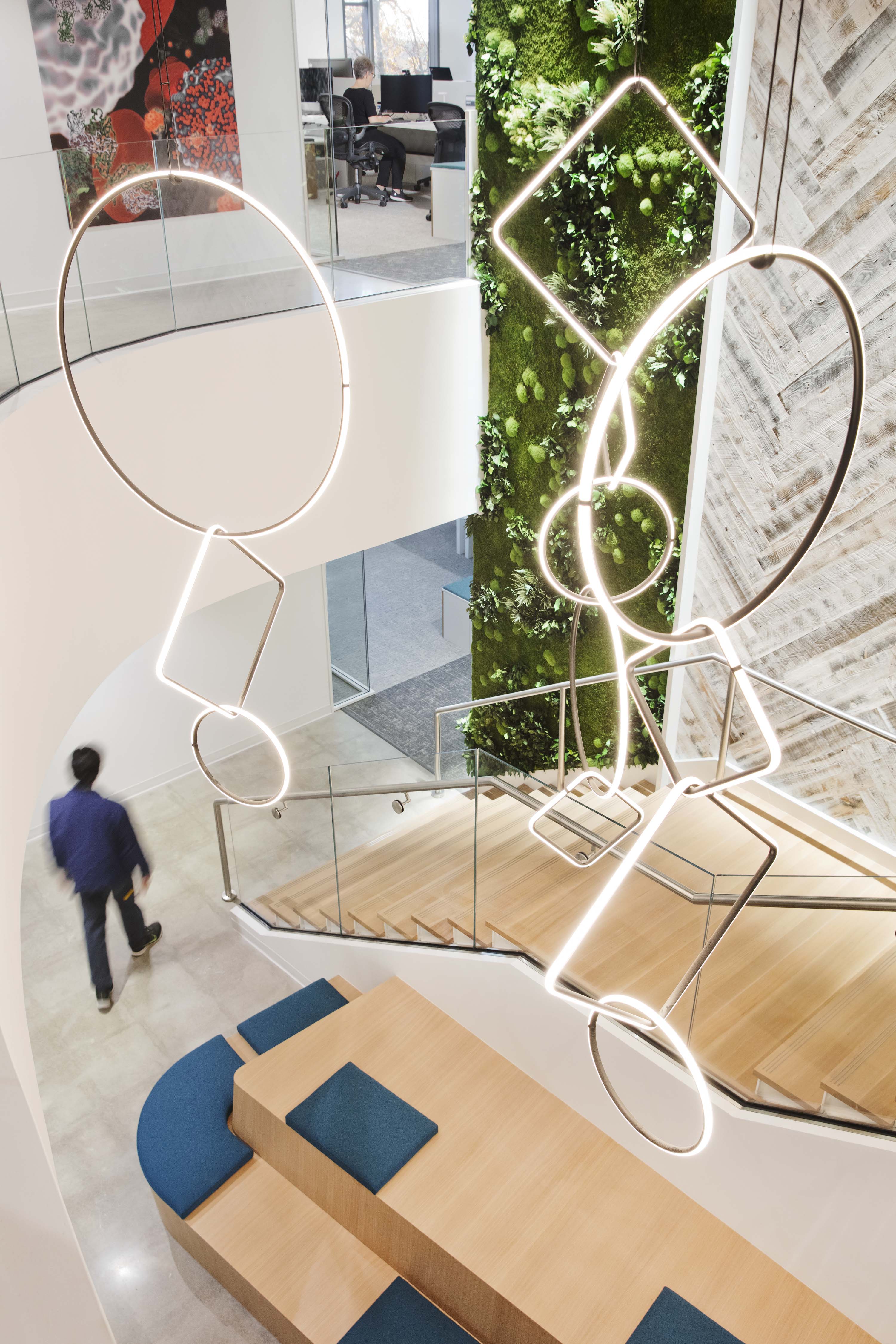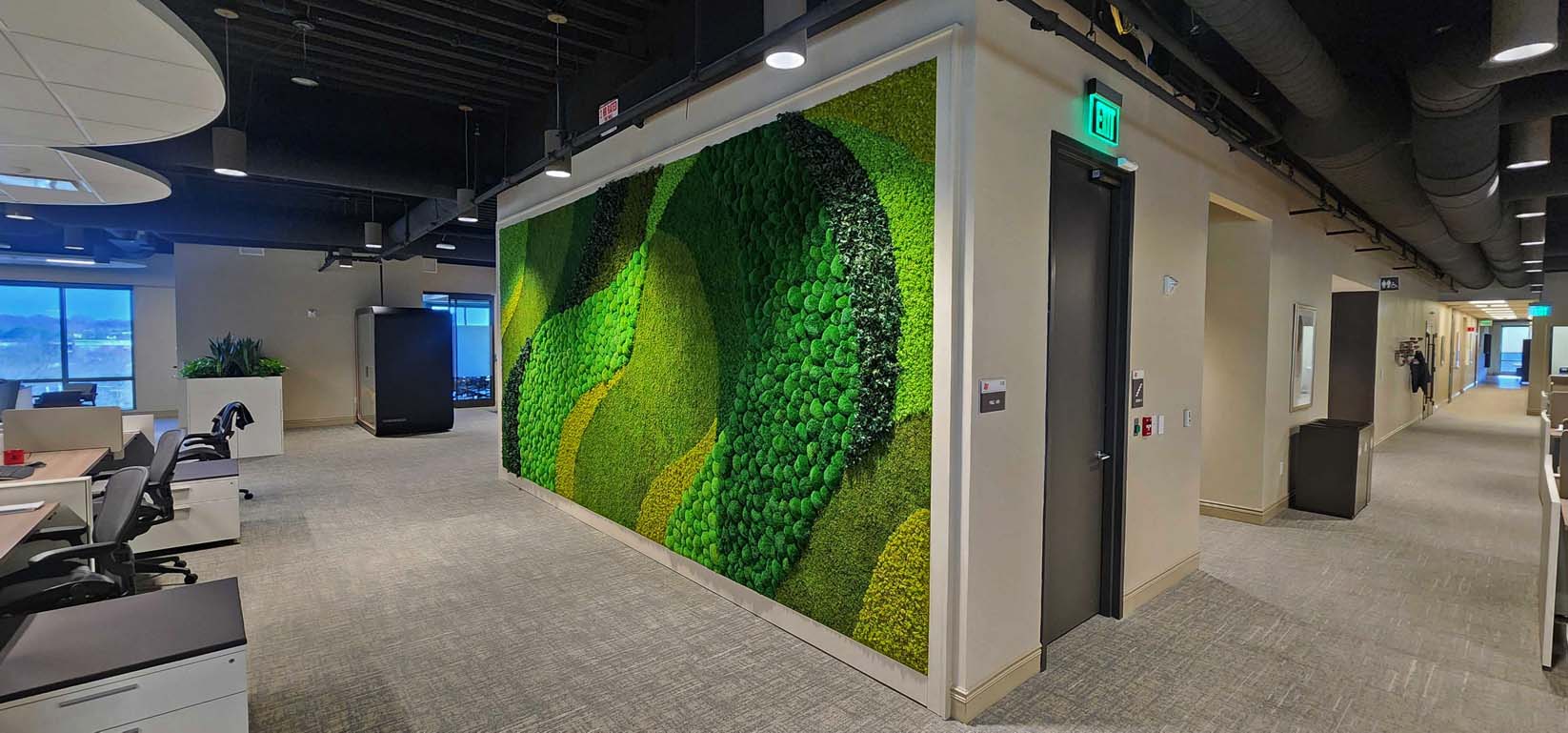Garden on the Wall®
The Science Behind Preserved Gardens, Moss Walls, Preserved Foliage Planter Inserts and Why They’re Good for You

Key Takeaways Before You Read the Full Article:
30 Second Executive Summary
This article explores the benefits of preserved plant walls, moss walls, and foliage planter inserts, highlighting how biophilic design can transform indoor spaces into restorative, human-centered environments.
🌿 Biophilic Design & Well-Being: Integrating preserved gardens indoors supports occupant mental, emotional, and physiological health by reducing stress, enhancing mood, and improving cognitive function.
🪴 Preserved Nature Elements: Moss walls, preserved gardens, and planter inserts offer maintenance-free, long-lasting greenery that brings the calming and restorative effects of nature into commercial, healthcare, educational, and residential spaces.
🎨 Design Versatility: These elements can be customized for any scale, from small accent pieces to large immersive installations, and creatively integrated into walls, furniture, or planters to enhance texture, visual interest, and spatial definition.
💡 Neuroscience & Physiological Impact: Exposure to preserved nature increases oxytocin, reduces cortisol, and fosters a sense of connection to the environment and co-occupants, promoting a salutogenic and restorative indoor experience.
✅ Sustainability & Material Health: High-quality preserved plant installations are sustainable, eco-friendly, and backed by certifications like HPD, Declare Label, and Common Materials Framework, ensuring occupant safety and transparency in material composition.
🌱 De-escalating & Normative Environments: Preserved plant walls help create calm, predictable, and socially supportive spaces, mitigating stress and encouraging familiarity, comfort, and engagement.
Ready to see how preserved gardens, moss walls, and foliage planter inserts can bring the benefits of nature indoors while enhancing design, sustainability, and occupant well-being? The full article covers scientific backing, practical applications, and design strategies for modern interior spaces.
In recent years, the integration of nature into our built environments has gained significant traction, with decorative plant walls emerging as a popular and scientifically backed solution. This trend is rooted in biophilic design, a concept that recognizes our innate connection to nature and seeks to incorporate natural elements into our living and working spaces. At the forefront of this movement are preserved plant walls, offering a sustainable and low-maintenance way to bring the outdoors inside.
Incorporating preserved foliage planter inserts into indoor spaces is a simple yet transformative approach to interior design. These inserts blend the beauty of preserved plants with the ease of maintenance, bringing a burst of life and color to any room without the need for ongoing upkeep. The strategic placement of foliage planter inserts can create focal points, delineate spaces, and add a layer of texture and richness to the indoor environment.
Understanding Preserved Gardens and Their Benefits
Preserved gardens are not merely decorative elements; they are sophisticated installations that bring the serenity and aesthetic beauty of nature into indoor environments without the high maintenance of live plants. These carefully curated gardens use scientifically advanced techniques to preserve the natural foliage, which means they require no watering, sunlight, or soil to remain vibrant. The inherent beauty of preserved gardens provides a timeless piece of nature that can last for years, making them not only an eco-friendly option but a cost-effective long-term investment in any space.
The benefits of integrating preserved gardens into our spaces extend beyond their visual appeal. Research in the fields of neuroaesthetics and environmental psychology suggests that being in or around nature—even preserved nature—can significantly reduce stress, improve mood, and enhance cognitive function. This connection to nature facilitated by preserved gardens can transform the dynamics of any indoor space, promoting a sense of well-being and calm in homes, offices, and commercial settings alike.
The Neuroscience of Nature: Neuroaesthetics and Neuroarchitecture
The positive impact of plant walls on our well-being isn’t just anecdotal; it’s grounded in the scientific fields of neuroaesthetics and neuroarchitecture. These disciplines explore how our brains respond to beauty and architectural elements, respectively. Research shows that exposure to natural elements, even in preserved form, can trigger positive neurological responses, leading to improved mood, reduced stress, and enhanced cognitive function. Applying the evidence-based design principles, we can establish a framework for crafting healthy, human-centric, and salutogenic* designs.
- Salutogenic design is an approach to creating environments that promote health and well-being by focusing on factors that support human health rather than on factors that cause disease. It emphasizes designing spaces that enhance people’s sense of coherence, manageability, and meaningfulness, ultimately contributing to improved physical and mental health outcomes.
The Physiological Benefits: Oxytocin Increase and Cortisol Reduction
One of the most compelling aspects of decorative plant walls is their ability to influence our body’s hormone production. Studies have shown that interaction with nature, including preserved plant installations, can increase oxytocin levels – often called the “love hormone” – which promotes feelings of well-being and social bonding. So not only this hormone increase the one’s connection to oneself, but also to their environment and to their cohorts in the same environment, increasing overall connection. Simultaneously, these natural elements (preserved gardens, moss walls, and preserved foliage planter inserts) have been found to reduce cortisol, the stress hormone, leading to decreased anxiety and improved overall mental health. What better way to craft human centric, wholesome and salutogenic design for your built environment!

Regenerative and Restorative Design: A Holistic Approach
Preserved plant walls exemplify the principles of regenerative and restorative design. Restorative Design reduces the harmful effects of design on nature and on human health, as well as enhancing the positive relationship between man and the natural environment. Regenerative Design enhances the health of the environment, increases biological diversity, and maintain living relationships with the surrounding environment. By bringing nature into our spaces by using these preserved gardens, moss walls, and planter inserts with preserved foliage, we’re not just decorating; we’re creating environments that actively contribute to human health and well-being. This holistic approach to design considers the long-term impact on both occupants and the environment, aligning with sustainability goals and promoting a healthier planet.
The Material Health and Occupant Well-being
The materials used in preserved plant walls are crucial to their overall impact on occupant health. While there are so many suppliers with no 3rd party testing but countless of pages of sustainability reports with zero attribution to 3rd party testing, Garden on the Wall®’s commitment to material health is evident in their adherence to stringent standards. Their products are compliant with the Health Product Declaration (HPD) v2.3 (disclosure up to 100ppm) for the whole garden system, Declare Label and Red List Free denominations with compliance to California Department of Public Health’s VOC Standards –still the only company in 2024 August with this kind of disclosure -, ensuring transparency in material composition to ensure the Occupant Health of the built environment is satisfied. It is a claim that only Garden on the Wall® can make in its field.
Sustainability and Third-Party Certifications
In line with the growing demand for sustainable design solutions, preserved plant walls offer a long-lasting, eco-friendly alternative to traditional live plants. Garden on the Wall®’s products boast impressive credentials, including the Declare Label and 3e Exchange Passport, demonstrating their commitment to transparency and environmental responsibility. These certifications align with the Common Materials Framework, ensuring that the materials used meet rigorous sustainability standards. Again Garden on the Wall® shines in its field as the unparalleled leader that offers the compliance to Common Materials Framework.
De-escalating Design and Normative Environments
Preserved plant walls contribute de-escalating environments*. These are spaces that naturally promote calm and reduce stress, crucial in high-pressure settings like offices or healthcare facilities. By creating a more normative**, nature-inspired environment, these installations can help mitigate the negative effects of artificial, sterile spaces often found in modern buildings.
- A de-escalating environment in interior design refers to a space intentionally crafted to reduce stress, anxiety, and aggressive behavior through the use of calming colors, soft textures, ample natural light, and thoughtful layout that promotes a sense of safety and comfort. Preserved garden, moss wall, and preserved foliage planter inserts are some of the best tools at interior designers’ toolbox to create a de-escalating environment through the use of nature (the ultimate calm downer) in designed space.
** A normative environment in interior design refers to a space that reflects and reinforces societal norms, expectations, and behaviors through its layout, furnishings, and aesthetic choices, often aiming to create a sense of familiarity and appropriateness for its intended use. The choice of using preserved gardens, moss walls and uniformly distributed preserved foliage planters throughout the space help designers create sense of familiarity, hominess and fascination to regulate the normal behavior in the designed space.
The Versatility of Preserved Plant Gardens, Moss Walls and Planters with Preserved Foliage
One of the key advantages of preserved plant walls is their versatility. They can be customized to fit any space, from small accent pieces to large-scale installations. This flexibility allows designers to incorporate biophilic elements into various settings, including corporate offices, healthcare facilities, educational institutions, and residential spaces.
Moss walls represent a fusion of artistry and sustainability, offering an eye-catching and innovative way to incorporate greenery into modern design. These walls are made from sustainably harvested moss that is then preserved through a non-toxic process, allowing it to maintain its lush texture and vibrant green color without any need for light or water. The versatility of moss allows for creative installations that can fit any aesthetic, from sleek, modern offices to cozy, rustic living spaces.
Beyond their unique aesthetic, moss walls offer tangible health and psychological benefits. Additionally, the presence of moss walls has been linked to reduced stress levels and increased productivity, creating amore pleasant and effective workspace.
Maintenance and Longevity
Unlike living plants, or even faux plants that would require constant dusting and cleaning, preserved plant walls require minimal maintenance while providing consistent visual and psychological benefits. This longevity ensures that the positive effects on occupants are sustained overtime, making them a cost-effective solution for long-term well-being improvements.
Conclusion: A Science-Backed Solution for Modern Spaces
The science behind decorative plant walls clearly demonstrates their positive impact on human health and well-being. By incorporating these elements into our built environments, we’re not just following a design trend; we’re making a conscious choice to create spaces that nurture our innate connection to nature. As we continue to understand the profound effects of our surroundings on our mental and physical health, the role of preserved plant walls in creating healthier, more productive, and more enjoyable spaces becomes increasingly clear.
Garden on the Wall®’s commitment to sustainability, material health, and biophilic design principles positions their preserved plant walls as a leading solution in this science-backed approach to modern interior design while offering ease of mind for interior designers, owners and GCs alike in satisfying all needs for all building types.
For more information on this subject and other related information, please visit our website: www.gardenonthewall.com
Related Posts

The Science Behind Nature Inspired Interiors and Human Happiness

The Neuroscience of Nature: How Preserved Gardens Impact Brain Function


